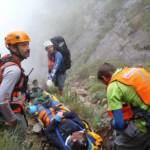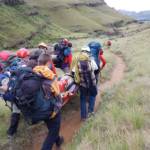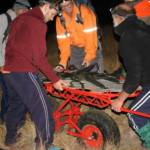This last post deals with emergencies that perhaps, are usually more low key, but get used all the time and they also have their place in saving lives.
There are four very easy and basic techniques for hikers and climbers to get themselves out of trouble when the injury or situation is not too serious . They might be used to take a person all the way out to safety or just to move them to a point where there is shelter and a full rescue can take place. How these are actually set and used needs to be demonstrated practically and I will not try to explain them in detail.
Firstly, there is the “confidence rope” technique. This is a general guiding skill for getting slow hikers to move faster and confidently. But it can also be used to help a person down a rough slope, who has some sort of injury and is lacking good balance and confidence. As a commercial guide, I have twice used this skill for injured people. Once in the southern ‘Berg with a broken ankle and once after a roped fall, high on the NE ridge of Mt. Kenya. All the person needed after the final abseil was done, was to be supported by a rope, while hobbling down through a boulder field,
Next there is the split-rope-coil carrying method, where a person carries the patient with the aid of a rope on their back. See pictures attached of this particular incident. There is also the two person split-rope-coil, which distributes the patients weight between two people . We used this technique to help a friend down the mountains in the Italian alps, after he had fallen down an ice slope. It was a very long 4kms, but it was on a good path some of the way and was far quicker than waiting for a rescue team.
A make shift stretcher can be made out of various materials including a length of rope. But it is important to remember that all these improvised stretchers are best used only for slightly inured people and who do not back or neck injuries.
Lastly, of the old style basic techniques, let me mention one that is fairly commonly used in the Drakensberg still today, for easy extraction of people who are not badly injured… the standard 4×4 horse is a good option!
The usual way that a professional rescue team carries a patient out of the mountains, is on a proper stretcher (rescue litter). It is a method often used when bad weather prevents a helicopter being used, or if it is in fact faster, simpler and cheaper to use a ground based team. There are some major issues however, when carrying a patient in this manner.
- It is extremely tiring for the carriers. To carry a person of just 50-60 kgs takes a team of about 15 people, rotating in turns of 6 at a time doing the carrying work.
- When traversing a slope or a contour path, the people on the up side of the litter, are walking bending down, while the down side are trying to lift the patient up. While all teams are carrying they are walking off the path over rocks and bushes.
- At night this becomes and even bigger issue. A rescue that took place in the northern Drakensberg some years back of a person of about 50 kgs being carried from Monte-aux-Sources hut to Sentinel car park, usually about a 2 hour hike, took an exhausting 7 hours with a team of about 14 people.
A huge improvement of a stretcher carry is when wheels are added underneath the litter of which there are various designs and configurations available. In the southern Drakensberg patients are often wheeled out on just such a stretcher.
For information on courses in mountain skills contact: gavin@peakhigh.co.za


